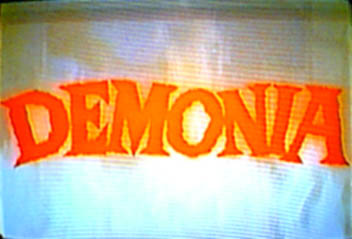
(Forgive my poor screen shots.)
Demonia begins in late 15th century Sicily, with the brutal crucifixion of five heretic nuns. The scene abruptly shifts to Toronto, 1990, where a girl named Liza (Meg Register) has a vision of the nuns' execution while in a trance at a séance. This brief prologue carries echoes of other Fulci films: "Liza" was the name of the central character of The Beyond, and the nuns' deaths are reminiscent of the murder of the painter Svejk in that film; while the séance is very similar to the one which opened City of the Living Dead, even down to the appearance of the medium.
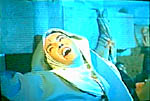
Unlike Mary Woodhouse in City of the Living Dead, Liza doesn't drop dead after her visions -- only unconscious. She is taken back home by her mentor, Professor Paul Evans (Brett Halsey), who chides her for her irrational interest in the supernatural. On his way out, Paul reminds her that they will be leaving for an archaeological expedition in Sicily later that day.
Once in Sicily, Paul, Liza and the archaeologists face a number of major problems. One is the overt hostility of the locals, who want the past to stay buried. Paul is totally uninterested in anything but the ancient Greek ruins in the area, but the locals are afraid he'll stir up the ghosts of the Dark Ages. It turns out they have reason to be concerned: it's Liza whose dreams and premonitions lead her to the medieval convent on the hilltop, where the dried bones of the crucified nuns wait thirsty for revenge...

The spirit of the long-dead Mother Superior is the next difficulty. Liza's visions draw her to the abandoned convent, where she thinks she can hear the sound of a heartbeat coming from a fresco depicting a medieval nun. Anxious to silence the awful heartbeat, Liza smashes the fresco, revealing a walled-off passageway behind it. At the end of the passage wait the bodies of the nuns. Liza returns several times to the crypt, sometimes in her dreams, and eventually witnesses the disappearance of the Mother Superior's corpse. In the meantime, people around Liza begin to die horribly and mysteriously...
The third big problem the archaeologists face is their own unbelievable stupidity. For scientists and scholars, they sure are an unprofessional bunch, more interested in drinking and singing "Molly Malone" (badly) around a campfire than doing any serious excavation. Every night they gather 'round the fire, hooting and slapping their thighs as one of their number plays the same two chords over and over and over and over and over and over and over and over again on his guitar. One of the archaeologists has brought her little son along and -- amazingly -- is annoyed at him for constantly getting dirty. Imagine, an archaeologist afraid of a little dirt! As far as I'm concerned, these idiots don't get killed off quickly enough.
The murders are unevenly presented. Al Cliver, playing a colleague of Paul's, gets killed by a headless naked nun-ghost wielding a harpoon gun (Yes, you read that right, and I'll say it again: a headless naked nun ghost wielding a harpoon gun. Maybe I'm being picky, but I just don't think 15th century headless naked nuns and harpoon guns are a good combination). Two archaelogists fall into a trap recycled from Manhattan Baby. A woman is maimed by her cats in what is probably (and unfortunately) the film's best-managed gore scene. Turi the butcher meets his end in his own meat locker, in a scene which starts out eerily and suspensefully, but which culminates in the most ridiculous tongue-mangling scene since Herschell Gordon Lewis' Blood Feast. Most spectacularly, a man is torn in two.. in a scene that would have been more effective if it had been better prepared. One moment the man is racing after a robed figure which is leading his child away -- the next moment he's tied between two saplings which are about to pull him apart. It makes no sense. It feels as if time and money and simply run out, and they wanted to get the movie over with.


Fulci himself has a substantial vanity role as "Inspector Carter of Interpol", though the killings seem hardly a matter for Interpol. "Carter"'s assistant does an extended, bewildering "Columbo" imitation, leading the already tenuous plot way off course by suggesting that Paul is under suspicion for the killings. Both policemen suddenly disappear before the movie's climax.

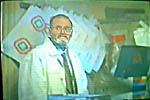
Paul's rational worldview crumbles around him as he sees Liza, bloodied and dressed in an ancient nun's habit, disappear in front of him. When he finally catches up to her in the convent catacombs, she stabs him. However, there seems to be a little bit of the human Liza left, because she doesn't finish killing him. Instead, she fades away and retreats, leaving him merely wounded.
In the meantime, the usual torch-bearing villagers have come to set fire to the dangling nuns. Liza appears on the center cross, vomiting thick yellow-green bile as the flames rise around her. As the bodies burn, and the bleeding Paul looks on in horror, Liza's lifeless body (in its regular clothes) materializes in front of the crosses. The end.

quickly forgotten by the director
as well as by even his most ardent fans.
-- Palmerini & Mistretta, Spaghetti Nightmares
(Key West: Fantasma Books, 1996)
Four "Lucio Fulci films" came out in 1988, more than had appeared in any one year since 1964. Of these, the blackly comic Quando Alice Ruppe lo Specchio/Touch of Death was slated for late-night television; I'm not sure whether it was ever actually broadcast. The other three, Demonia, Ghosts of Sodom and Zombie 3, are considered by many to be Fulci's very worst movies.
Only 7 years had passed since Fulci's last great achievement, House by the Cemetery, yet those 7 years had seen him break with producer Fabrizio di Angelis and writer Dardano Sacchetti, the onset of debilitating illnesses, and the rapid decline of public interest in splatter films. According to Sacchetti (in several interviews), Fulci had tried to go off on his own as an auteur, turning his back on the people who had helped establish him in the late 70's and early 80's. But, said Sacchetti, he wasn't capable of being a true auteur -- without a capable writer or director of photography, he was nothing.
Sacchetti's bitterness is understandable; after all, his former colleague did take him to court, alleging he'd stolen a script idea from him. But I think the truth about Fulci is a little more complicated. It's true that Fulci did some of his best work with Sacchetti, and when he was faced with scripts by lesser writers (even those he wrote himself), he was unable to bring them to life as convincingly. But let's face it: we don't remember films like Fulci's for their scripts, or even their scenarios: we remember them for their total execution, and this is why we give ultimate credit to the director. You have only to see a Sacchetti-signed film by a director like, say, Lamberto Bava to realize that Fulci brought as much to Sacchetti's work as Sacchetti brought to him.
The director's job is to fit together the work of a large number of people -- the actors, the technicians, the crew -- into something resembling his vision of the film. This is an incredibly difficult thing to do, considering all the creative input that comes from each of the artists involved in the production... be it the writer, the composer, the editors, the cinematographer, the actors... yet when a director is able to put together the contributions of all these people into something recognizeably his own, he deserves to be granted some measure of respect. When Fulci had the chance to work with a better class of writers and technicians, like Sachetti for example, or directors of photography Sergio Salvati or Luigi Küweiler, he got better results from them than other less capable directors could, or did.
With Demonia, Fulci did not have a first-rate team. Fulci himself wrote the script, along with Pietro ("Nipples") Regnoli. Heading a cast of unknowns were B-movie stalwart Brett Halsey, and Meg Register, whose odd beauty made her look good as a horror heroine, but who simply can't act. The movie was scored by an inexperienced composer named Giovanni Cristiani, and the cinematographer, Luigi Ciccarese, was best known for skin flicks and Bruno Mattei movies. This is hardly a promising lineup, and in fact Demonia is a very disappointing film from the director of The Beyond. But Demonia is still very watchable, in spite of its shortcomings, and shows that a poor film by Fulci is often more enjoyable than the best efforts of, say, a Mattei or an Andrea Bianchi.
The worst aspect of Demonia is probably its cinematography, which sinks the picture like a human head tied to an anchor. Fulci had wanted a dreamlike atmosphere for the film, so many of the outdoor scenes were shot through a scrim. The photographer is supposed to shoot through the mesh to give a sort of fuzzy glow to the scene. Unfortunately, in several scenes Ciccarese or his assistants misjudged the focal length, so that the scrim in front of the lens is clearly visible. It's like watching the movie through mosquito netting. What's more, Ciccarese seems to have done a very poor job monitoring light-levels, a particular problem when shooting in sun-drenched Sicily. For example, during the scene in which Halsey and Register meet Al Cliver on his boat, Cliver stands with his back to the sun. Consequently, all the shots facing Cliver are wshed out and over-exposed, while the shots of Halsey or Register have an entirely different light-quality. A similar problem occurs in the scene in the fortune teller's house -- as the camera spins, following the woman in her compulsive circling, the frame washes out each time it reaches the window. And all the scenes in the dark convent crypt suffer badly when a character's flashlight turns towrd the camera (I had originally seen Demonia in an n-th generation VHS dub, transferred from PAL to NTSC. The print was so grainy that no real details were visible. Watching the unforgivingly clear DVD from Media Blasters' new Shriek Show line, I was amazed at how much better Demonia is when you can't see it clearly!).
The musical score rivals the camerawork for ineptitude. I found the main title music to be aimless and irritating, but worst of all is the music whic accompanies the "climax" of the film. Not only is it awful in its own right, it's also out of character (and out of synch) with the events it underscores.
Fulci's and Regnoli's script is extremely juvenile, but the poor music and photography tend to distract the viewer from its shortcomings. Watching the movie for the first time is like going on a blind date with someone whose bad breath and awful taste in clothes almost -- almost -- cover up his or her total lack of character.

And yet, amazingly enough, there is enough genuine Fulci in the result to make Demonia worth suffering through at least once. I think the scene in the library is one of the highlights of the film -- though nothing happens, the atmosphere and dry stillness of the place give the scene a feeling of real menace. The rows and rows of dusty, abandoned books made me think of the dessicated bodies in the catacombs. Another good bit is the cat attack: fake though it is, it comes off better than the similar bird attack at the end of Manhattan Baby. And the scene in which Turi the butcher enters the crypt is lit so that the empty eye sockets of the crucified nuns seem to be shifting toward the intruder's flashlight...

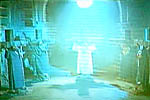
Demonia's convent scenes were filmed in a real Sicilian catacomb. Around them as they filmed were boxes, biers and niches containing real human remains -- local tradition being to keep the ancestors on display. This gives the mise-en-scène and unsettling atmosphere, even though the remains are obviously more recent than the 15th century. I'm not sure if the scenes of the crucified nuns were filmed on a soundstage, or in an empty section of the catacomb; but if they did shoot in the crypt, I hope they cleaned up behind them. The walls of that chamber were festooned with astrological symbols, and the names "Lucifer", "Azathoth" and "Cthulhu" -- enough to give any subsequent visitors quite a shock.
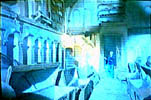

The other locations for the film, in the Sicilian town- and countryside, would have been spectacularly beautiful had they not been so poorly filmed. I don't think Demonia ever received theatrical distribution, so I think Media Blasters' DVD gives the film as good a presentation as it's ever had. The DVD preserves the film's original aspect ratio of about 1.66:1. Some of the scenes are as breathtakingly clear as if they had been shot yesterday; unfortunately, the movie's technical mistakes are captured with equal clarity. Though the disc promises an interview with Brett Halsey as an extra, this interview turns out to be a text excerpt from a magazine. Also included on the disc is the short video "Fulci Lives!", shot while Fulci was setting up the gory bisection scene. Chances are the dedicated Fulciphile will have seen this before, probably on Anchor Bay's release of The Beyond; but it has to be admitted that this disc is the proper place for it.